-

Federer-Djokovic: The Power Of Patterns
In Part One of this series we looked at the overall matchup between Federer and Djokovic. This was something of a “tale of the tape”, comparing the strengths and weaknesses of each player and rating who had the advantage in which areas. Understanding this is critical for gaining a fuller perspective on matches between these two players. However strokes are only tools – things that can be used to good (or bad) effect through the choices of the player using them. The greatest ball striker in the world won’t win many matches making poor decisions on what shots to try to hit.
Over time players evolve their own style of playing, and as a part of that style they create tactical habits, otherwise known as patterns. These patterns allow a player a highly practiced sequence of events that, if done properly, greatly increase their chances of winning a point. The flip side is that many players, even at the professional level, have some poor patterns of play that decrease their odds of winning a point. And over time, many players’ games change – often they do not adapt their patterns to these changes. An aging player might lose some footspeed, but have improved touch. He cannot continue to play as he did when he was 23. A prime example of this is Federer’s resurgence in 2014 which was spurred in large part by a shift in strategy to include attacking the net more often and shortening points.
In today’s article, we are going to revisit the Wimbledon final match of 2015 between Federer and Djokovic. The focus will be on two key patterns that had a huge impact on the outcome of the match. In one of these patterns, Federer plays the correct shot which keeps him neutral in the point. In the other, lies complete and consistent disaster.
The Importance of Height And Angle
In the previous article we referenced several times the fact that Djokovic’s ideal contact point is higher than most other player’s. He plays his best tennis on a higher plane, with the ball around the shoulders. This is a critical part of the matchup between Dokovic and Federer – when Federer keeps the ball lower he tends to do better against Djokovic than when the ball gets up into Djokovic’s strike zone.
The second part of the puzzle though, and in truth the critical part, is angle. Back in 2013 we posted an article about the importance of the cross-court ball in singles. When we hit a ball truly cross court, it minimizes the amount of recovery movement we are required to make, and also reduces our errors.
Against Djokovic, controlling the height and getting the ball cross court of the center take on even more importance. Better than most people, Djokovic takes the high, center-court forehand and punishes his opponent. It’s the ball his stroke was practically built to hit. His disguise is excellent, and he can take it equally well in both directions. Without further ado, let’s look at how these two things combine to impact the outcome of this final.
The Crux
This pattern is all based around a single decision on the part of Federer. Since his prime back in 2004-2007, Federer’s movement has slowed. He is still an excellent mover, but he simply isn’t as quick around the court as he was 10 years ago. In some ways he has adapted his patterns well to this change in his game – his increased net play is an example of this. Unfortunately in others he has not adapted, and that lack has hurt him badly. So let’s talk about the moment of truth, the crux of this discussion: the on the run backhand.
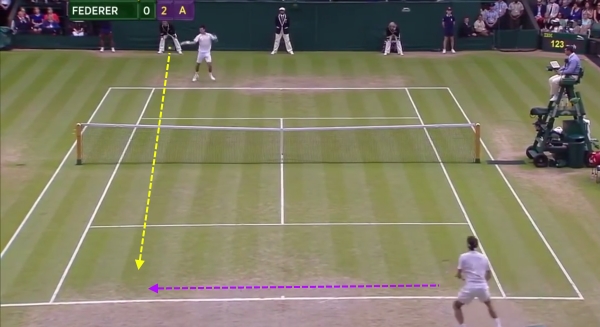
This is a scenario that Federer faces in many variations often when playing Djokovic. In the moment captured above, Djokovic is about to hit a forehand down the line into Federer’s backhand corner. Federer will be running laterally across the baseline to hit a backhand on the move. What happens next for Federer is a critical decision. He has several things he must decide. The first is direction – down the line or cross court? The second is what stroke to use – the topspin backhand or the slice?
As it turns out, the first decision can often limit the second. Federer has greater reach with the slice, and the ability to pull almost any ball cross court. With the topspin, Federer can hit fewer balls truly cross court. This is where adapting becomes important. Ten years ago, Federer’s lateral movement was so good that he could get many balls cross court with his topspin backhand that today he is simply a half-step too slow to do so with.
Why is that so important? Because of what happens when Federer tries to pull the on-the-run topspin backhand cross-court and fails to do so. What does that look like? Read on and find out!
Pattern 1: The Topspin Backhand
We begin with a series of images that show a sequence from an actual point from that Wimbledon final.
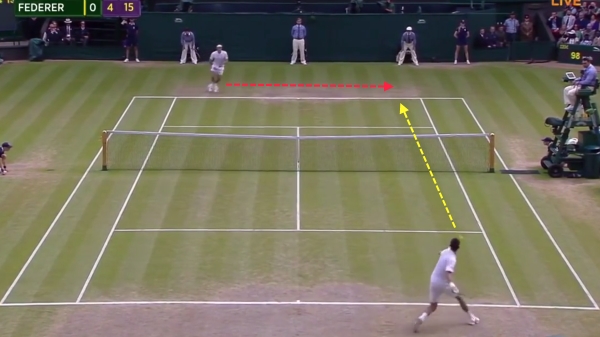
This first image shows where Djokovic creates the on-the-run backhand for Federer. He takes a forehand down-the-line into Federer’s backhand, forcing Federer to run across the court to hit his backhand. In this sequence, he will attempt to hit his backhand with topspin cross-court.
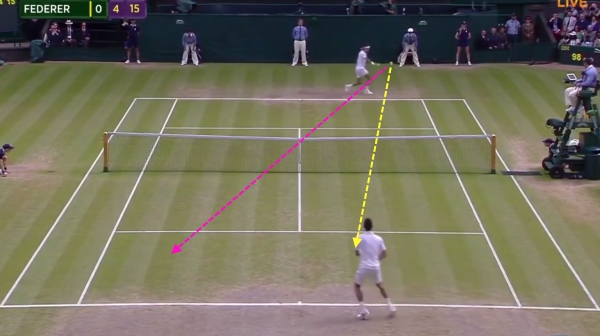
This is Federer around the moment of contact. There are two lines on the image. The pink line represents what Federer would like to do with this ball. If he were able to get it cross court with any kind of pace, he would essentially punish Djokovic for the change of direction in his previous shot. Ten years ago, he would likely have pulled this off by being just a touch faster to get to the ball.
Instead his shot follows the yellow line. This in itself is not good, but would not necessarily be disastrous. Except for the second part of the equation mentioned above – height. When he hits the ball on the yellow line, he hangs it up near shoulder high for Djokovic.
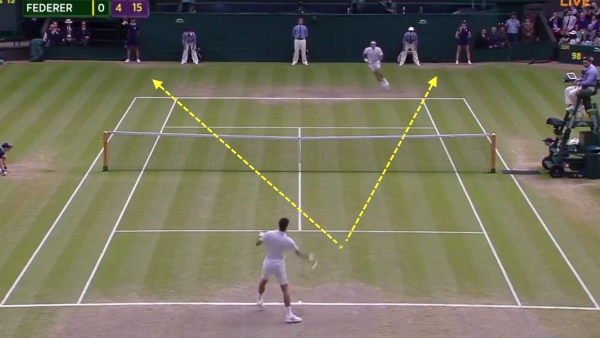
Here is the problem in a nutshell for Federer when he hits the topspin backhand and doesn’t get it cross-court. Djokovic is in a central position, with a higher ball and all the options available to him. He can take it aggressively in either direction, with good disguise. Federer is caught scrambling, trying to return to a neutral recovery position but you can see in this image he’s not really even close. For this ball position, he should be right around the center mark.
In this case, Djokovic takes the ball to the left and hits a winner by a comfortable margin. But importantly if he had gone back behind Federer he likely would have hit a winner also, catching the Swiss in his recovery.
When this pattern of play takes place, Federer will lose the vast majority of points – certainly well below 50%. It is, in summary, a losing pattern for Federer and one that he must avoid at all costs. So what is the alternative?
Pattern 2: The Slice Backhand
The alternative is for Federer to take the slice backhand low and cross court. This is an effective play for him on all surfaces, but especially on the grass and especially against Djokovic. Djokovic certainly has a great backhand, but the shot is not at its best on the lower balls. Let’s take a look at what this pattern looks like.
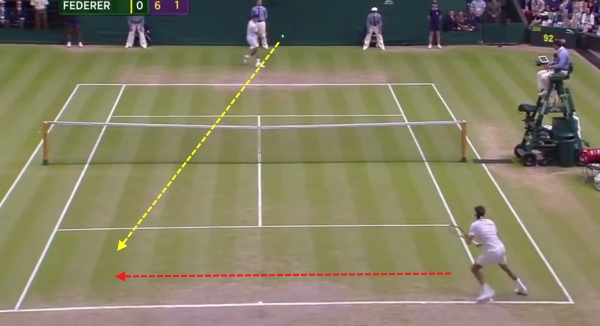
In the first image of this sequence, we see that Djokovic gets Federer well and truly on the run. Indeed this looks like a perilous situation for the Swiss. He has a lot of ground to cover, and he’s looking at the same situation that he had above, except this time Djokovic is in even better initial position to get a forehand in the middle due to his more central positioning.
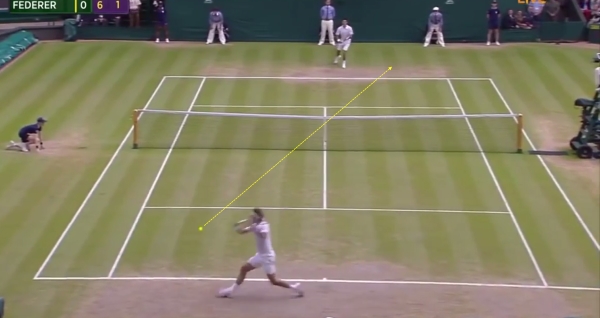
This time however, Federer takes his backhand cross-court as a slice. Because of the nature of the shot, he can still get the ball genuinely cross court despite the fact he is hitting it on the run and somewhat stretched. As we see in the following frame, this changes everything.
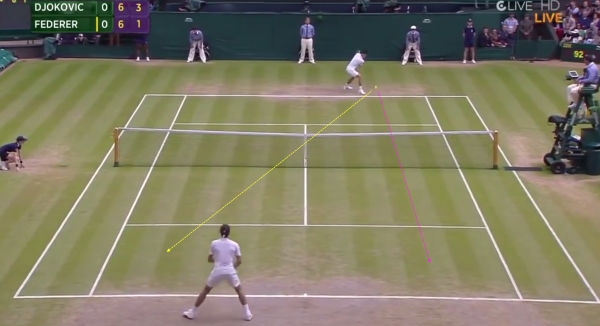
Suddenly, Federer is at the very least in a neutral position in the point. Djokovic is stuck hitting his backhand from a lower contact point than he enjoys. The two arrows above represent the options Djokovic has available. The pink is a high-risk shot for Djokovic. He must hit over the highest part of the net into the shortest part of the court off a low ball that his stroke is not well designed for. Additionally he is then taking the ball into a forehand that, although diminished, is still one of the best in the game today.
Meanwhile the yellow line represents, for Djokovic, safety. He can play a high percentage shot into Federer’s weaker side – an easy decision to make. And so this is the choice that Djokovic makes – he takes the ball cross court. Of course when we look at the image, we see that Federer is in perfect position to handle this shot. It will take minimal movement for him to reach the ball and suddenly he has the initiative, two shots after being deeply on defense. From here Federer has at least even odds of winning the point – significantly improved over hitting the topspin in the same situation.
Conclusion
Across the course of the match, Federer faces this situation multiple times at critical junctures. Unfortunately for his fans, he frequently made the wrong choice, opting to try to hit over the ball and in doing so giving Djokovic his dream forehand on big points. It is difficult to say if this is a matter of hubris – does Federer not realize the odds on the pattern he chooses are not in his favor? Or is he simply panicking, reacting in the moment and falling back on patterns that served him well ten years ago?
Regardless it had a huge impact on the outcome of the match. Many of Djokovic’s patterns are designed to get Federer hitting his backhand on the run, and in doing so earn himself the very ball Federer so conveniently served up to him. In a match where the margins were so small, choosing the better play a mere handful of times may very well have earned Federer a Wimbledon title. This is also shows how small the margins at the top of the game are. On such small things, careers are changed.
Like this article? Follow us on Facebook!